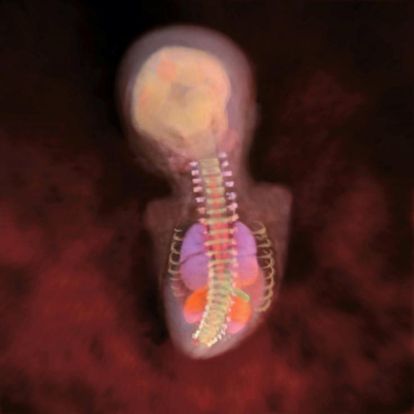14 weeks and 6 days pregnant

Your baby is starting to swallow amniotic fluid more regularly: this enters the stomach (seen here as a dark circle in the centre of the abdomen). The tiny bladder is also visible as a black fluid-filled structure within the lower pelvis.
The neural tube, the basis of your baby’s spinal cord, developed in the very early weeks; now the spinal cord is fully formed.
Nerves from your baby’s spinal cord are linked to each set of vertebrae, but as your baby lengthens the spinal cord does not grow at the same rate, and the lower tip ends up lying at the mid-lumbar level, half way between the hips and lowest rib.
Below the mid-lumbar level, the nerves leaving the spinal cord have lengthened so that they still exit between the lowest vertebrae. In adult life, the cord will end slightly higher than in the newborn baby. Because the spinal cord does not extend the entire length of the vertebral canal, a fluid-filled space fills the lower portion.
By the end of this week, your baby is able to use fat as a source of energy. This isn’t, however, an important source of energy because that need is met largely by glucose crossing the placenta from your bloodstream. Free fatty acids in your circulation easily cross the placenta to your baby and are used for organ growth, forming cell walls, making myelin sheaths around nerves to insulate them, and for many other functions.
Cholesterol is not only supplied to your unborn baby via the placenta, but he is also forming it within his own body. For this reason, your cholesterol level bears little relation to your baby’s, which needs to be high for your baby to produce fat, especially in the first few months of pregnancy.

In this computer-generated image , the internal organs of the fetus can be seen. The skull, spine, and rib cage are also clearly visible. The lungs (pink) are protected by the rib cage; the kidneys (red) are below.
Your baby could be tuning in to your favourite TV show!
Research examined babies of mothers who watchedNeighbourswhile pregnant alongside women who didn’t. After the birth those babies who had been exposed to the music in the uterus became quiet and “paid attention” to the tune; the other group of babies ignored it.
When can my baby first suck his thumb?
Ultrasound scans have shown unborn babies sucking their thumbs from as early as 12–14 weeks of pregnancy. However, this is likely to be a reflex at this stage as the brain does not have any conscious control over movement until the fetus is much more developed later on in pregnancy.
Some research has suggested that if an unborn baby shows a preference for sucking, for example, his right thumb, then he will prefer to lie with his head turned to the right after the birth. The same research suggested that this preference could be used to predict right- or left-handedness in the baby as he grows older.
Be the first to support
Be the first to share
Comment (0)
Related Blogs & Vlogs
No related events found.
Loading more...